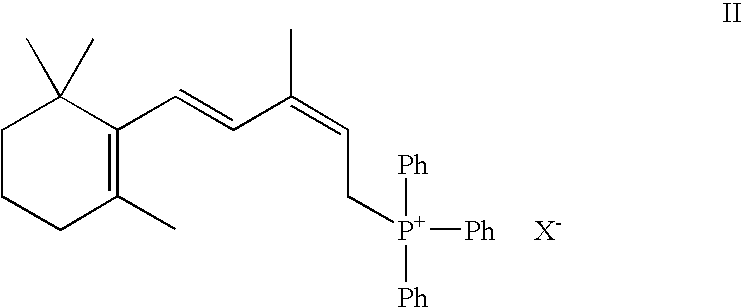Process for the production of 9-(Z)-retinoic acid
- Summary
- Abstract
- Description
- Claims
- Application Information
AI Technical Summary
Problems solved by technology
Method used
Image
Examples
example 1
[0034]a) Isolation of 9-(Z)-C15-triphenylphosphoniumchloride
[0035]200, 0 g of an oily concentrate containing an isomeric mixture of 9-(Z)- and 9-(E) C15-triphenylphosphoniumchloride (E-content 18%, Z-content content 36%) was taken up and mixed with 400 ml of methylene chloride under an argon atmosphere at 20 to 25° C. The water phase was separated, and then 1000 ml ethylacetate were added in the course of 5 to 10 minutes at 15 to 25° C. 35 ml n-butanol was then added to the clear orange-brown solution previously obtained. The ethylacetate and methylene chloride was distilled off at 28 to 33° C. / 180 to 200 mbar, whereby the amount which was distilled off was replaced with 1600 ml of ethylacetate. Crystallization of the 9-(Z)-C15-triphenylphosphoniumchloride was initiated with 0.2 ml of a suspension of 9-(Z)-C15-triphenylphosphoniumchloride at 30 to 35° C. The suspension was then stirred for another 2 to 3 hours at 30 to 35° C. The crystals were then filtered, washed with 400 ml of et...
PUM
| Property | Measurement | Unit |
|---|---|---|
| temperature | aaaaa | aaaaa |
| reaction temperature | aaaaa | aaaaa |
| temperatures | aaaaa | aaaaa |
Abstract
Description
Claims
Application Information
 Login to View More
Login to View More - R&D
- Intellectual Property
- Life Sciences
- Materials
- Tech Scout
- Unparalleled Data Quality
- Higher Quality Content
- 60% Fewer Hallucinations
Browse by: Latest US Patents, China's latest patents, Technical Efficacy Thesaurus, Application Domain, Technology Topic, Popular Technical Reports.
© 2025 PatSnap. All rights reserved.Legal|Privacy policy|Modern Slavery Act Transparency Statement|Sitemap|About US| Contact US: help@patsnap.com



